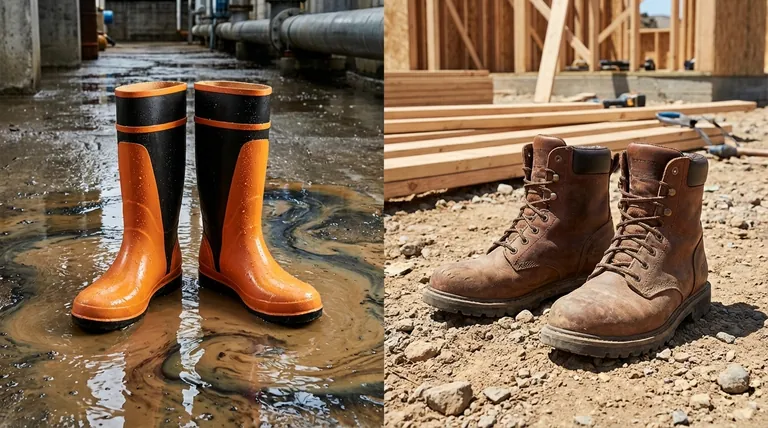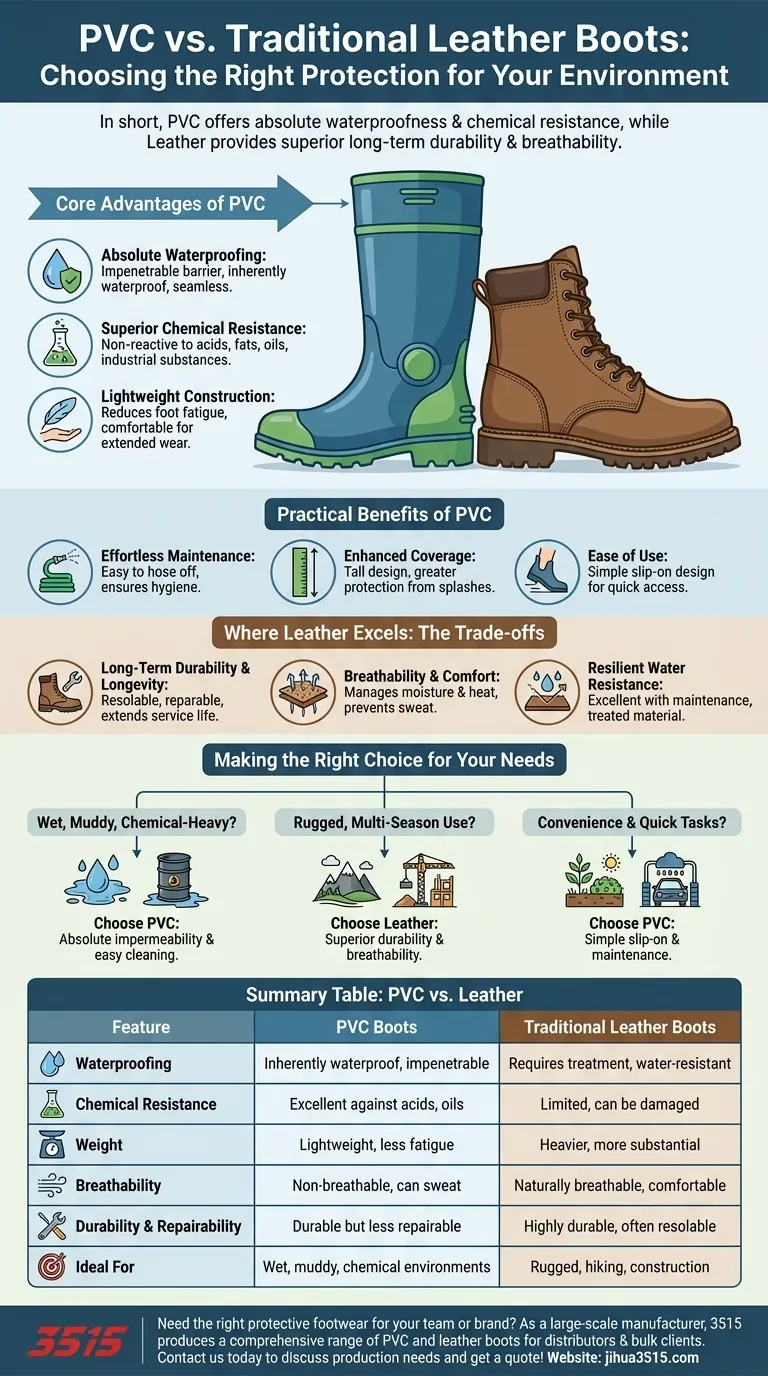In short, the primary benefits of PVC boots are their absolute waterproofness and chemical resistance. They are a lightweight, easy-to-clean, and durable solution designed for complete protection against liquids and harsh substances, often featuring a taller design for greater coverage than typical leather boots.
The choice between PVC and leather is not about which is "better," but which is right for the task. PVC provides an impermeable barrier for wet or hazardous environments, while traditional leather offers superior long-term durability, reparability, and breathability for rugged, multi-season use.

Unpacking the Core Advantages of PVC
Polyvinyl chloride (PVC) is a synthetic plastic polymer. Its material properties make it exceptionally well-suited for creating protective footwear designed for specific, challenging conditions.
Absolute Waterproofing
Unlike leather, which is a porous natural material that requires treatment to be water-resistant, PVC is inherently waterproof. Its seamless, molded construction creates an impenetrable barrier against water, mud, and other liquids.
Superior Chemical Resistance
PVC is non-reactive to a wide range of acids, fats, oils, and other chemicals. This makes PVC boots an essential piece of safety equipment in agricultural, industrial, and food processing environments where exposure is common.
Lightweight Construction
Compared to the dense, heavy nature of high-quality full-grain leather, PVC is significantly lighter. This reduces foot fatigue over a long day of work, making the boots more comfortable for extended wear.
Practicality in Demanding Environments
Beyond its core material strengths, the typical design and maintenance of PVC boots offer distinct practical benefits.
Effortless Maintenance
The non-porous surface of PVC makes cleaning incredibly simple. Contaminants like mud, chemicals, or organic matter can be hosed off easily, ensuring hygiene and preventing cross-contamination.
Enhanced Coverage and Protection
PVC boots are often designed as "Wellingtons" or gumboots, featuring a tall shaft that extends up the calf. This provides far greater coverage and protection from splashes and deep puddles than standard-height leather work boots.
Ease of Use
The simple, slip-on design of most PVC boots makes them quick and easy to put on and take off. This is a significant convenience in environments where you frequently move between clean and dirty areas.
Understanding the Trade-offs: Where Leather Excels
Objectivity requires acknowledging that PVC is not the ideal choice for every situation. Traditional leather boots hold their own distinct advantages.
Long-Term Durability and Longevity
High-quality full-grain leather is known for its exceptional durability and ability to last for many seasons. Leather boots can often be resoled and repaired, significantly extending their service life beyond what is possible with a molded PVC boot.
Breathability and Comfort
Leather is a naturally breathable material, which helps manage moisture and heat from your feet. PVC, being a non-porous plastic, does not breathe, which can lead to sweat and discomfort during strenuous activity in warmer conditions.
The Nature of Waterproofing
While PVC is completely waterproof out of the box, well-maintained leather can also provide excellent water resistance. Furthermore, some references note that leather's waterproofness is inherent to the treated material itself, whereas some synthetic boots rely on a liner that can fail over time.
Making the Right Choice for Your Needs
Your decision should be driven entirely by your primary use case and environment.
- If your primary focus is working in wet, muddy, or chemical-heavy environments: Choose PVC for its absolute impermeability, ease of cleaning, and lightweight protection.
- If your primary focus is rugged, multi-season use like hiking or heavy construction: Choose leather for its superior long-term durability, breathability, and potential for repair.
- If your primary focus is convenience and quick protection for tasks like gardening or washing a car: Choose PVC for its simple slip-on design and effortless maintenance.
Ultimately, selecting the right boot means matching the material's inherent strengths to the demands of your environment.
Summary Table:
| Feature | PVC Boots | Traditional Leather Boots |
|---|---|---|
| Waterproofing | Inherently waterproof, impenetrable barrier | Requires treatment, can be water-resistant |
| Chemical Resistance | Excellent against acids, oils, and chemicals | Limited, can be damaged by chemicals |
| Weight | Lightweight, reduces foot fatigue | Heavier, more substantial |
| Breathability | Non-breathable, can cause sweat | Naturally breathable, more comfortable |
| Durability & Repairability | Durable but less repairable | Highly durable, often resolable and repairable |
| Ideal For | Wet, muddy, chemical-heavy environments | Rugged, multi-season use, hiking, construction |
Need the right protective footwear for your team or brand?
As a large-scale manufacturer, 3515 produces a comprehensive range of PVC and leather boots for distributors, brand owners, and bulk clients. We offer durable, purpose-built footwear tailored to your specific environmental demands.
Contact us today to discuss your production needs and get a quote!
Visual Guide

Related Products
- Premium KPU Injection Athletic Style Safety Shoes
- Premium High-Cut Waterproof Safety Boots Manufacturing & Wholesale Solutions
- High Performance Fire-Retardant Waterproof Safety Boots
- Heavy-Duty Waterproof Nubuck Safety Boots Safety Shoes for Bulk Supply
- Premium Wholesale Waterproof Safety Boots High Performance Protection for Industrial Markets
People Also Ask
- How are boots designed to meet the ASTM protective toe standard? A Guide to Impact & Compression Safety
- Why is expert help recommended when selecting safety shoes? Ensure Perfect Fit & Hazard Protection
- What are the impact ratings for SAFETY TOE tactical work boots? Essential Protection Explained
- What is the purpose of puncture-resistant footwear? Protect Your Feet from Sharp Hazards
- Does allowing employees to wear steel-toe rubber boots offsite exempt the employer from payment? Understand OSHA's specialty PPE rules.



















